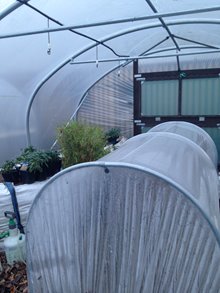February is the start of a busy growing season for a polytunnel gardener. The climate inside your polytunnel is a few weeks ahead of the great outdoors, making now the best time to start sowing summer crops.
While the weather in February can be bitterly cold, windy, snowy and frosty, the temperature inside a polytunnel will be on the rise as the sun is warmer and daylight hours are getting longer.
Continue reading our guide to find out what to plant in February or get in touch if you need polytunnel growing advice.
What do I need to grow plants in February?
 Some serious seed sowing can start this month but the cold weather means that extra equipment is needed until the UK heats up. This includes:
Some serious seed sowing can start this month but the cold weather means that extra equipment is needed until the UK heats up. This includes:
- A heated propagator to give seeds in pots or modules the heat they need to germinate.
- A polytunnel to raise hardy outdoor crops a few weeks before they go outside. These sowings will thrive with the extra protection and warmth that a polytunnel provides, putting them ahead in the growing game.
- A polythene cloche to act as 'double glazing' inside your polytunnel or greenhouse and keep frost off your crops.
What are the best fruits, vegetables and flowers to sow or plant in February?
Fruit and veg seeds to sow in February
- Tomato – In late February, sow three or four seeds in a small pot filled with seed compost. Water well and store the pot at around at 18°C, either in heated propagator or in a clear plastic bag in a sunny spot.
- Sweet peppers – Sow pepper seeds from mid-February by filling seed trays or small pots with moist compost. Place seeds in, cover with a thin layer of vermiculite and let the seeds germinate. Peppers thrive at temperatures of 18-21°C, so put yours in a heated propagator for better results.
- Carrots – Sow seeds thinly in light, well-drained soil and cover with a cloche or fleece. Seeds may take a while to germinate, so be patient and put protection in place to combat pests.
What flowers can I plant in February in the UK?
You have a few good options for flowers to plant in February, from those that flower in the summer to hardy perennials. Consider the likes of:
- Geraniums
- Petunias
- Impatiens
- Nicotianas
- Cosmos
- Sweet peas
- Salvias
- Lilies
Which crops can I harvest in February?
You may have some crops ready to harvest in February if you planted them in the previous year. Fruit and veg you may be able to harvest include:
- Brussel sprouts
- Cabbage
- Celeriac
- Parsnips
- Leeks
- Bay leaves
- Kale
- Rosemary
- Stored apples
February gardening tips
- Keep an eye on soil temperature – Winter brings air temperatures low enough to freeze plants. Monitor temperatures and combat cold soil with cloches, mulch or polythene film.
- Tidy up overwintering crops – Remove weeds and dead or diseased leaves, and keep a lookout for slugs and caterpillars. Some overwintering crops like peas and broad beans may need extra support from canes and strings. Crop Bars are great for supporting canes.H2: Complete routine polytunnel maintenance
Your polytunnel itself may also need care and attention throughout February. Here's what you can do to keep it in top-notch condition:
- Tidy – Keep the inside tidy and free from clutter, so you have a productive space to garden in. Use Algon to clean your polytunnel cover, too.
- Repair – Ensure your polytunnel is free from cuts or holes by using repair tape. This prevents heat loss, so your polytunnel continues to work as you'd expect it to.
- Clear snow – Remove snow on your polytunnel to reduce strain on its frame. Simply knock off snow using a brush or place an electric heater inside the polytunnel to melt more stubborn snow.
- Remove pests – Inspect your plants for pests and remove them as needed. Consider placing your propagating trays or pots on staging to reduce the risk of pests getting to them.
Grow plants this February with a new polytunnel
Looking to do some Polytunnel growing in winter? February is the ideal time to pick one up. We have plenty of polytunnel sizes to choose from, so you can find a great option for your outdoor space.
If you have a question about our polytunnels or growing crops in yours, contact us on 01282 811250 or email info@premierpolytunnels.co.uk to speak to our friendly experts.